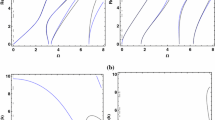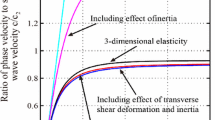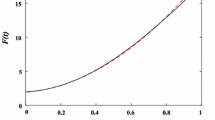Abstract
A mathematically correct approach to the analysis of Pocklington’s equation for thin electric vibrators, based on the theory of singular integral equations, is suggested. A new singular integral equation is obtained for the derivative of the surface current with respect to the longitudinal coordinate. Numerical treatment demonstrates rapid convergence and computational simplicity of the proposed method.
Similar content being viewed by others
References
Computer Techniques for Electromagnetics, Ed. by R. Mittra (Pergamon, Oxford, 1973; Mir, Moscow, 1977).
D. M. Sazonov, SHF Antennas and Devices: A Handbook for Radio Engineering Specialties of High School (Vysshaya Shkola, Moscow, 1988).
G. A. Erokhin, O. V. Chernyshev, N. D. Kozyrev, and V. G. Kocherzhevskii, Antenna Devices and Radio Wave Propagation: A Handbook, Ed. by G. A. Erokhin (Radio i Svyaz’, Moscow, 1996).
A. N. Tikhonov and V. Ya. Arsenin, Solutions of Ill-Posed Problems (Nauka, Moscow, 1986, 3rd ed.; Halsted Press, New York, 1977).
S. I. Éminov, Radiotekh. Élektron. (Moscow) 38, 2160 (1993).
V. A. Neganov, E. I. Nefedov, and G. P. Yarovoi, Strip Lines and Slot Lines for Super High and Extremely High Frequencies (Nauka, Moscow, 1996).
V. A. Neganov, E. I. Nefedov, and G. P. Yarovoi, Modern Methods of Designing Transmission Lines, SHF and EHF Resonators (Pedagogika-Press, Moscow, 1998).
V. A. Neganov and I. V. Matveev, Fiz. Voln. Protsessov Radiotekh. Sist. 2(2), 27 (1999).
Handbook of Mathematical Functions, Ed. by M. Abramowitz and I. A. Stegun (Dover, New York, 1971; Nauka, Moscow, 1979).
F. D. Gakhov and Yu. I. Cherskii, Convolution Type Equations (Nauka, Moscow, 1978).
S. I. Éminov, Method of Eigenfunctions of Singular Operators in the Diffraction Theory in Application to Electrodynamic Analysis of Vibrators and Slit Antennas, Author’s Abstract of Doctoral Dissertation in Mathematical Physics (Novgorod, 1995).
Author information
Authors and Affiliations
Additional information
__________
Translated from Pis’ma v Zhurnal Tekhnichesko\(\overset{\lower0.5em\hbox{$\smash{\scriptscriptstyle\smile}$}}{l}\) Fiziki, Vol. 26, No. 12, 2000, pp. 86–94.
Original Russian Text Copyright © 2000 by Neganov, Matveev, Medvedev.
Rights and permissions
About this article
Cite this article
Neganov, V.A., Matveev, I.V. & Medvedev, S.V. A method for reducing Pocklington’s equation of electric vibrators to a singular integral equation. Tech. Phys. Lett. 26, 535–538 (2000). https://doi.org/10.1134/1.1262903
Received:
Issue Date:
DOI: https://doi.org/10.1134/1.1262903




